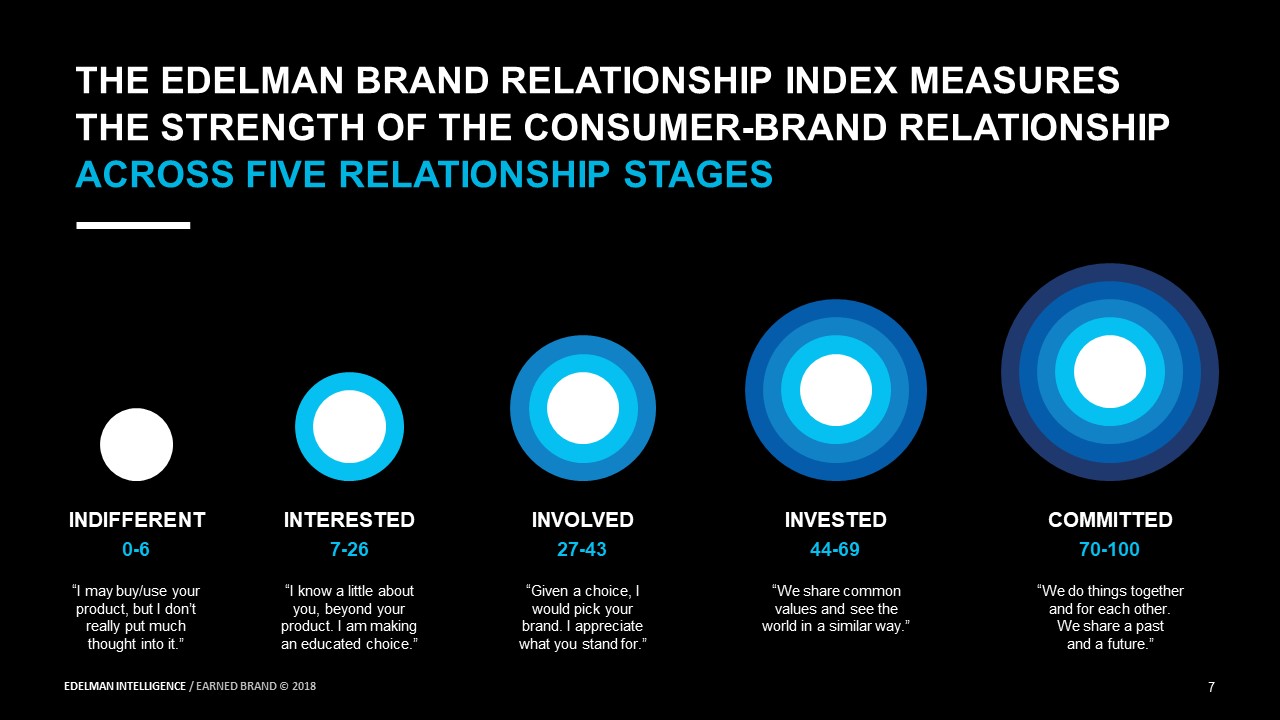A version of this post appeared on Edelman Intelligence.
The latest research from the 2018 Edelman Earned Brand survey points to what we believe is nothing short of a sea change in the context in which consumer-brand relationships are forming and evolving. The driver of this change is the mainstreaming of the Belief-Driven-Buying mindset. What does that mean? It means that more consumers than ever before are deciding to switch, choose, avoid, or boycott a brand based on its stand on societal issues. Over the past year, this mindset spread from 51 percent of the population to 64 percent. This single event has the potential to usher in what could be a golden age of consumer-brand bonding and relationship development.
Let me explain why.
Let’s start with the fundamentals. When measuring brand relationships, we look for indicators of how enmeshed a brand is in people’s lives. In this way, we uniquely measure a type of bond between consumers and brands that can manifest in a form of loyalty that shows up not just as repeat or exclusive purchasing when things are going well, but also by continued purchasing even when there are good reasons to switch. This is a loyalty that will lead someone to keep their accounts with Wells Fargo despite it repeatedly getting fined, to get the new Samsung Galaxy even after the 7 was recalled, or to buy a VW in the face of the emissions test scandal.
We believe, contrary to what some others have said, that relationship strength is a form of brand equity that is of increasing importance. In fact, we have found relationship strength as we measure it using the Edelman Brand Relationship Index (BRI) to be directly tied to the tendency of a brand’s customer base to be the first to buy its new innovations, advocate for it among their peers, defend it against critics and remain loyal to it in the face of competitive pressures. Using the BRI, we have identified five levels of consumer-brand engagement going from Indifferent to Committed.

Moving across the five relationship stages. A healthy brand is one that is mindful of both where the bulk of their current customers are on this continuum and is successfully executing strategies designed to move their key consumer segments up to the next level. To that end, moving people from Indifferent to Interested is best done by focusing on your offer. For example, building the impression that the quality of your brand’s products and services is far better than its competitors.
In contrast, the transition from an Interested to an Involved relationship is less about product specifications and more about growing the perception that my association with the brand reflects well on me and that the brand “gets me” as a person. It is in this transition that we see a pivot on the part of consumers from a brand relationship based on a product orientation to one based on a values or lifestyle orientation.
Getting from Interested to Invested requires that a brand goes from being seen as a token of some aspect of my self-identity to sharing my identity. For example, the perception that the brand and the customer share the same positions when it comes to controversial societal and political issues is the brand trait that increases the most in importance between these levels and it goes up even further between Invested and Committed.
This framework, based on an examination of over 100,000 consumer-brand relationships, assumes that a brand that is viewed merely as a product cannot become as fully integrated into someone’s life as a brand that is also viewed as a lifestyle element. From a relationship building point of view, emphasizing your product and its attributes will only get you so far – essentially somewhere between Interested and Involved.
Here is the opportunity part. Our research shows that Belief-Driven Buyers tend to have deeper relationships with their favorite brands. This is because their focus on a product’s stand on issues makes them more likely to have a values or lifestyle orientation towards brands. Essentially, the importance they place on having shared positions on social and political issues increases their sensitivity to a brand characteristic that we have found to be a defining element of Invested and Committed relationships. Thus, the mainstreaming of Belief-Driven Buying is a golden opportunity for brands to build stronger consumer relationships.
In fact, Belief-Driven Buying should be a CMO’s dream. It is a growing movement that has a lot of emotional energy to tap into. It drives lots of media attention – both social and traditional. And, being responsive to it will facilitate bonding consumers to you in ways that me-too brands will not be able to replicate. While ingredients, price points, and product features can be easily co-opted by a competitor, a relationship cannot, especially one based on lifestyle fit, shared values, and co-action around causes that matter to both parties.
Still, some brands may be wary when it comes to making their positions on contentious issues publicly known, if for no other reason than it is likely that any stand they take will result in some people not agreeing with them, sometimes to the point of setting their products on fire. Still, as uncomfortable as brands may find taking such a risk to be, they are likely to find becoming irrelevant to be even less pleasant. Or, perhaps put more poetically, faint heart never won fair lady.
David M. Bersoff, Ph.D., is Head of Global Thought Leadership Research, New York.




